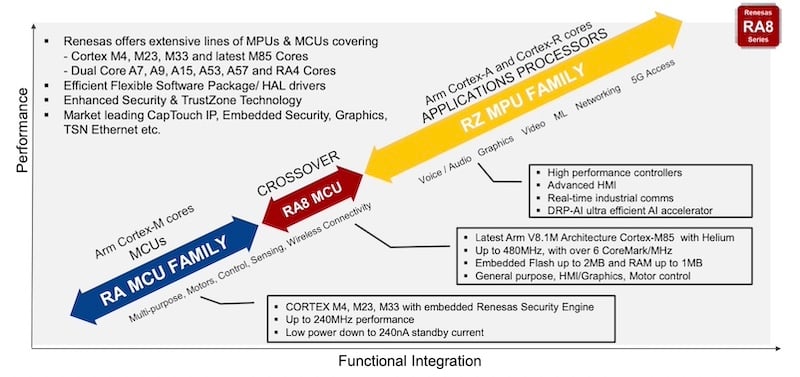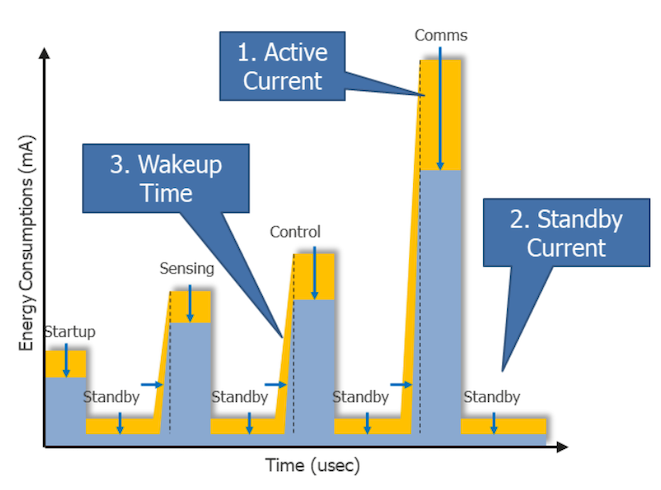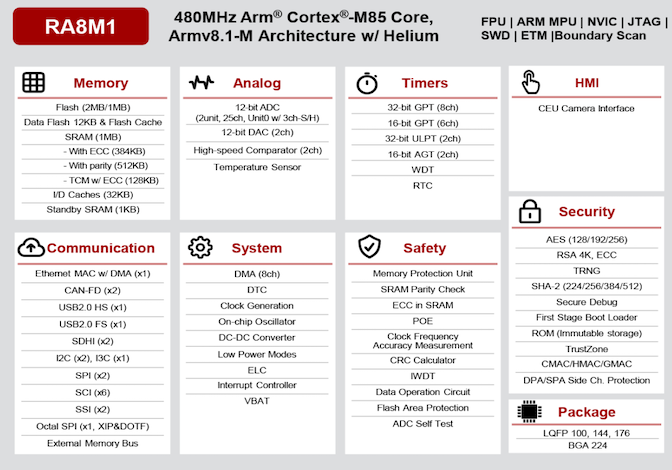Renesas Unveils Industry’s First MCUs Based on Arm Cortex-M85 Core
The new family of devices aims to bridge the gap between low-power MCUs and high-performance MPUs.
Historically, microcontrollers (MCUs) and microprocessors (MPUs) have been two distinctly different things. Whereas MCUs have been meant for low power system control and monitoring tasks, MPUs have been used for higher-performance processing of complex workloads.
Now, with the rise of intelligent edge devices and workloads like machine learning (ML), the lines between MCUs and MPUs are starting to blur. Suddenly, there is a need for devices that offer the low-power performance and peripherals of MCUs but can also handle the complex processing workloads of MPUs.

As performance needs grow, the lines between MCUs and MPUs are beginning to blur.
Today, Renesas launched their new RA8 series of MCUs which aims to bridge the gap between MCUs and MPUs through a combination of high performance and low power. All About Circuits had the chance to interview Kavita Char, principal product marketing manager for Renesas, to learn more about the big release firsthand.
Bridging the Gap with the RA8 Series
Renesas’ new RA8 Series was born out of the glaring needs of customers who are moving computation to the edge in droves. Speaking to the impetus for the RA8 Series, Char explains “What we are finding in the market is a lot of our customers are looking to build in the support for AI processing on the edge. While we have a strong lineup of MCUs and high-performance MPUs, we really wanted something that was going to bridge the gap between them.”
From a performance perspective, Renesas introduced a number of unique architectural and system-level advances to the RA8 family of devices.
The features of the RA8M1 group. (Click image to enlarge)
First, is the fact that the RA8 family offers the industry’s first 32-bit MCUs built around the Arm Cortex-M85 core. The core, based on the Arm v8.1-M architecture, brings improvements such as an improved in-order pipeline with a 7-stage scalar pipeline, a 9-10 stage vector and floating point pipeline. Arguably most important, however, is the newfound support for both Arm TrustZone and Helium (MVE).
Explaining the importance of Helium, Char explains “Helium is basically a single instruction multiple data (SIMD) vector extension to Arm’s instruction set that accelerates DSP and AI/ML tasks.”
“Many of the architectural enhancements that Arm has made to this core allow for almost 30% scalar performance uplift over the M7, and we have seen almost up to 4× performance uplift on this.”

Helium support on the Arm Cortex-M85 core provides 3.6× speed up in interference time on a Plumerai inference application.
As part of this, the RA8 family runs up to 480 MHz, double that of Renesas’ famous RA family of MCUs. Because of these improvements, the RA8 family has proven impressive performance of over 3,000 CoreMark points as well as an industry-best score of 6.39 CoreMark/MHz performance. According to Renesas’ testing, this translates to a 3.6× improvement in inference time as compared to previous devices.
Improving Power Efficiency
Right off the bat, the improvement in CoreMark (an EEMBC benchmark) is an indicator of improved power efficiency in the device. “This basically means that we can run the Cortex-M85 core at a slower frequency and get the same sort of performance as an alternative device running at a higher frequency,” says Char. “Without sacrificing performance, we’re immediately saving power.”

A typical low-power MCU use case
Beyond that, however, a major improvement from a power-efficiency perspective is Renesas’ introduction of a VCC/VCC2 concept. The concept is that the MCU has two power domains, which can run at different voltage levels all the way down to 1.8 V. With this, designers can connect low-power external components to a 1.68 V domain, while keeping other systems running at 3.3 V. In this way, the system is more flexible and can operate at a lower power overall.
Other improvements to the low-power architecture include low standby current thanks to an efficient 40 nm process, state retention for faster wake-up times, and an array of low-power modes. According to the company, the RA8x1 has a typical power consumption of 225 µA/MHz in active mode, and deep software standby modes as low as 1.47 µA.
Building an Intelligent Edge
With a combination of power and performance, the RA8 family seems extremely well-suited to the needs of edge computing. Closing out, Char explains “When we provide this higher level of performance on MCUs, we support our customers in being able to do those compute-intensive tasks without switching to MPUs. And that is the main driver: helping customers build edge intelligence as easily as possible”
The first device in the RA8 family, the RA8M1 Group, is now available for purchase.








